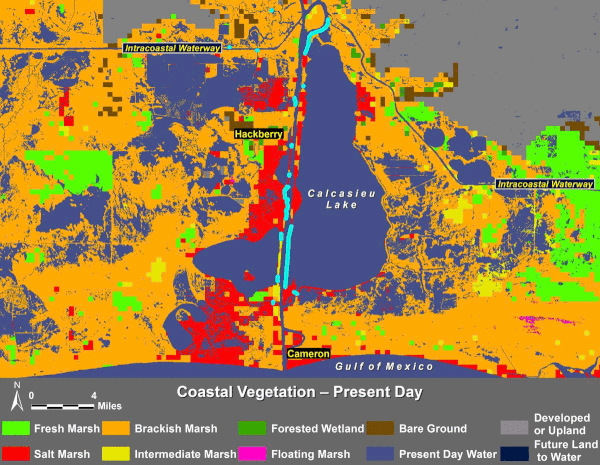This Massive Coastal Restoration Project Will Defend Southwest Louisiana
To restore Louisiana’s coast, we need a suite of large-scale restoration projects across the coast working together to deliver maximum benefits to reduce land loss, restore ecosystems, and maintain healthy and diverse habitat. In our “Restoration Project Highlights” series, we take a deeper look at specific projects from our list of Priority Projects, highlighting why they’re needed and hearing local perspectives on importance.

Conceptual graphic of a Lake Wall Navigation Sill. Credit CPRA
The Chenier Plain, located in Southwest Louisiana, is part of the Calcasieu-Sabine Basin and home to the Calcasieu Ship Channel. While the Calcasieu Ship Channel is a critical asset for navigation for the entire region, it also poses one of its greatest threats—allowing increasing amounts of salt water into nearby ecologically important freshwater marshes. Since it was dredged in the 1800s, the channel has eroded to over forty times the original size. The Gulf Intracoastal Waterway, constructed in the early to mid-1900s and cutting through the basin, has allowed further saltwater intrusion.
The ever-increasing flow of salt water into marshes and surrounding wetlands via these channels has altered the hydrology of the region and turned healthy and productive freshwater marshes into open water.
What is needed to combat further land loss in Southwest Louisiana?
The changing hydrology of the region, resulting from manmade actions to deepen access canals for navigation, is the cause of most of the land loss occurring in the Chenier Plain. The Calcasieu Ship Channel Salinity Control Measures project would manage salinity levels to maintain fresh and intermediate marsh, while reducing bank and shoreline erosion.
The project includes construction of sill and wall structures, bank stabilization measures and salinity control gates around these channels. These structures will include areas for fish gaps and boat access.

Location of the Calcasieu Ship Channel Salinity Control Measures project
A local’s take on the Calcasieu Ship Channel Salinity Control Measures project
Why is this project important?
Given the severity of land loss and future risks, this one large-scale project could have a greater impact on reducing saltwater intrusion than a variety of smaller projects across the region.
This project will reduce saltwater intrusion into the basin, helping to stabilize land loss and create new land in the long term. It will also provide a synergistic benefit to other coastal restoration projects in the basin by helping to reduce the salinity and stabilize hydrology in Calcasieu Lake and nearby wetlands.
The construction of this project is estimated to create 12,685 acres of land in the long term (50 years).
When will this project be constructed?
This project is currently undergoing engineering and design and the estimated cost of completing this project is $432 million. Construction is currently slated to begin in 2021 and will likely last 36 months.
What does a future without action look like?
Future with action assumes all projects in the 2017 Coastal Master Plan are operating.
What does a future without action look like?
|
What does a future with action look like?
|
 |
 |
How will this project benefit wildlife?

Diamondback Terrapin turtle (U.S. Fish and Wildlife Service)
The Calcasieu-Sabine Basin is home to the Sabine National Wildlife Refuge—one of the premier locations for wintering waterfowl in Louisiana. Cormorant and egrets are some of the birds that commonly nest at the refuge. Many neotropical migratory songbirds also take refuge here during the winter on their migratory routes.
This basin also provides nurseries in its marshes to important commercial fisheries including shrimp and various species of fish. Marshes offer important refugia and protection for juveniles of many species. This project will help stop saltwater intrusion into these marshes, preserving these important nurseries.
One species that will benefit from this project is the diamondback terrapin. Found in Louisiana’s brackish coastal marshes, these are smaller turtles with females only reaching about 11 inches long. They are difficult species to study as they are elusive and little is known about their abundance and distribution in coastal Louisiana. Diamondback terrapins are threatened by the loss of fringe coastal habitat, but this project will help restore the important intermediate marsh which they prefer.
Be a voice of support for this critical restoration project! Sign up here:
Sign up here to stay updated on this project and to hear about opportunities to advocate for its completion.